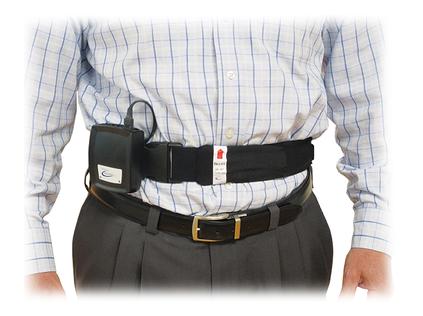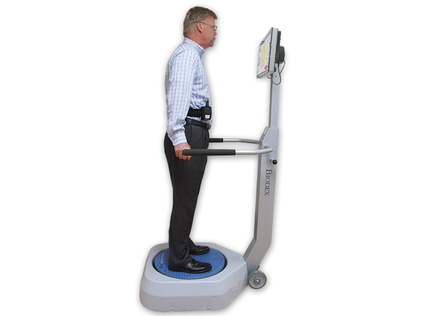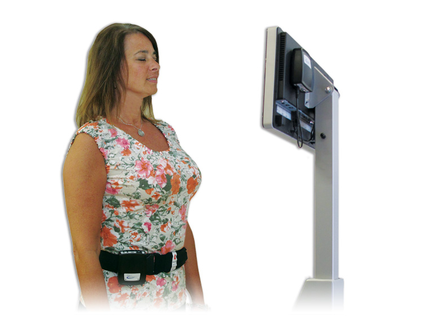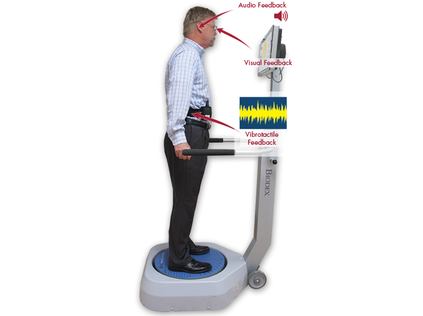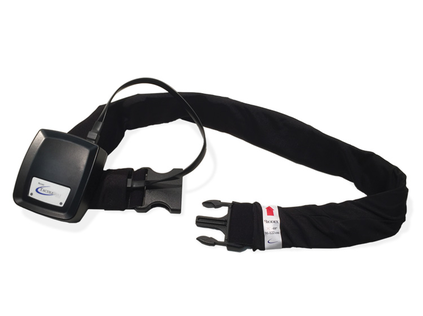- Physical Medicine Home
- Products
- Programs
- Applications
- Find a Clinic
- Blog
- Events
- Education & Training
- In The News
- Press Releases
VibroTactile™ System
Vibrotactile feedback is especially suited for evaluation and treatment of vestibular disorders.
| Overview | Applications | Specifications | Manuals | Models and Ordering |
Overview
You are expecting a call. You’re in a place where a ringing cell phone is bad form so you put your phone on vibrate. When the phone “rings”– you don’t see it or hear it – but you know exactly where it is. That is vibrotactile cueing.
Vibration cueing adds sensory feedback
Providing real-time biofeedback during rehabilitation is essential for patients and clinicians. Once integrated with the Balance System™ SD or the portable BioSway™, the optional VibroTactile System offers an additional form of sensory feedback to help detect changes in postural sway. Using wireless technology, the tactile belt responds with a vibrating sensation when the patient sways outside the therapist-set parameters.
Adds sensory enrichment to therapy tasks
Real-time biofeedback is an important component of balance rehabilitation. Typically therapists cue patients with a tap or verbal command. Vibrotactile cueing heightens the therapy process by adding a mechanized, reproducible sense and objective feedback. More pronounced than audio and visual feedback, vibrotactile cueing directly engages the motor learning system, promotes neuroplasticity and reducing falls.
Especially suited for evaluation and treatment of vestibular disorders
Vibrotactile cueing allows patients to safely receive positional feedback with their eyes closed. Patients with vestibular challenges are overly dependent on visual and somatosensory systems. To bring a greater focus to the vestibular system during balance training, the visual sense needs to be eliminated.
Vestibular therapy includes balance training exercises which, when coupled with vibrotactile feedback as one of the interventions provided by physical therapists, has been shown to improve postural control.1
The principle behind the technology
Research and clinical experience demonstrate that vibrotactile cues that correct postural sway in one situation are retained and transferred to other types of situations. Vibrotactile cueing fosters adaptation to new, correct information.
The origin for this specific technology is from the military, to enhance spatial awareness for jet pilots, with sensors embedded into their flight suits. Since then, the technology has been adapted to balance rehabilitation with excellent results.
|
Vibrotactile Feedback Study demonstrates how vibrotactile feedback improves balance rehabilitation. |
References
| 1 | Whitney SL, Alghwiri A, Alghadir A. (2015). Physical therapy for persons with vestibular disorders. Pubmed.gov, 61-8. doi: 10.1097/WCO.0000000000000162. |

Applications
- Vestibular disorder
- Balance anxieties
- Stroke
- Proprioception such as peripheral neuropathy
- Cognitive impairment
- Amputation
Specifications
Belt
- Dimensions: 28”-36” (71-91 cm)
Transmitter
- Voltage: 5v DC
- Current: 50 mA
- Auxiliary Ports: RS-232; USB
Receiver Box
- Voltage: 5v DC
- Current: 260 mA (when charging)
- Auxiliary Ports: USB (wired); LR-WPAN (wireless)
- Total Shipping Weight: 5 lb (2.3 kg)
- Warranty: One-year parts and labor
Compatible with Windows CE, 7 and 10.
Field updates available
Manuals
Models and Ordering
To order, call 1-800-224-6339
| 950-430 | VibroTactile™ System Includes transmitter, two tactile belts (S/M and L/XL), each with wireless receiver and connection cables. |
Primary Resources
Additional Documentation
Related Biodex Programs
What They Are Saying
360 Balance & Hearing
Bridgett Wallace, PT, DPT
“I have been using the Biodex VibroTactile System for some time now. It is showing to be a useful tool to improve weight shifting, as well as provide feedback about postural sway... ”
... read more >
In The News
Biodex Medical Systems, Inc. to feature the latest additions to their Balance & Mobility line of rehabilitation devices at APTA Combined Sections
... read more >

